Building an Author Box That Actually Improves Trust Signals
Key Takeaways
- Author boxes provide essential information about the writer, such as their name, background, and social media links.
- They contribute to building genuine trust with readers by showcasing a human connection behind the content, boosting credibility and engagement rates.
- Author boxes act as trust signals that influence how search engines, readers, and AI algorithms view content, enhancing trust, credibility, and authority.
Author boxes, or author bio boxes, are sections at the beginning or end of a blog post that provide information about the author of the post.
They include the author’s name, background, experience, and links to their social media profiles.

Search Engine Land’s profile of Adam Heitzman, co-founder and managing partner at HigherVisibility.
Author boxes help your website build genuine trust with your readers.
Readers see an actual human behind your content, and that adds to the credibility and relevance of your website. It can also increase engagement rate, especially if the author is well-known and the readers value their opinion.
In this article, I’ll share three key steps to create author boxes that help you gain the trust of web users. Before then, let’s explore why it matters.
Why Author Boxes Matter
If Dave Ramsey or any other expert on personal finance writes a blog post on your website, your readers may want to read to the end because they believe whatever they write will be helpful.
That’s how author boxes are. They’re trust signals that incentivize readers to stick around and read what you (or any other author on your site have written.
The author box does three things that directly impact how search engines, readers, and LLMs like Chat GPT, Perplexity AI, etc., view your content:
- It boosts trust and credibility
When readers can see who wrote the piece, they trust it more. This is because they’ve read the author’s experience and expertise, and they trust that the author has the authority to write (or speak) on the topic.
That’s instant credibility.
Here’s an example from Gina Shaw, an author at WebMD. She studied English, and has been a health journalist for over 20 years at WebMD:
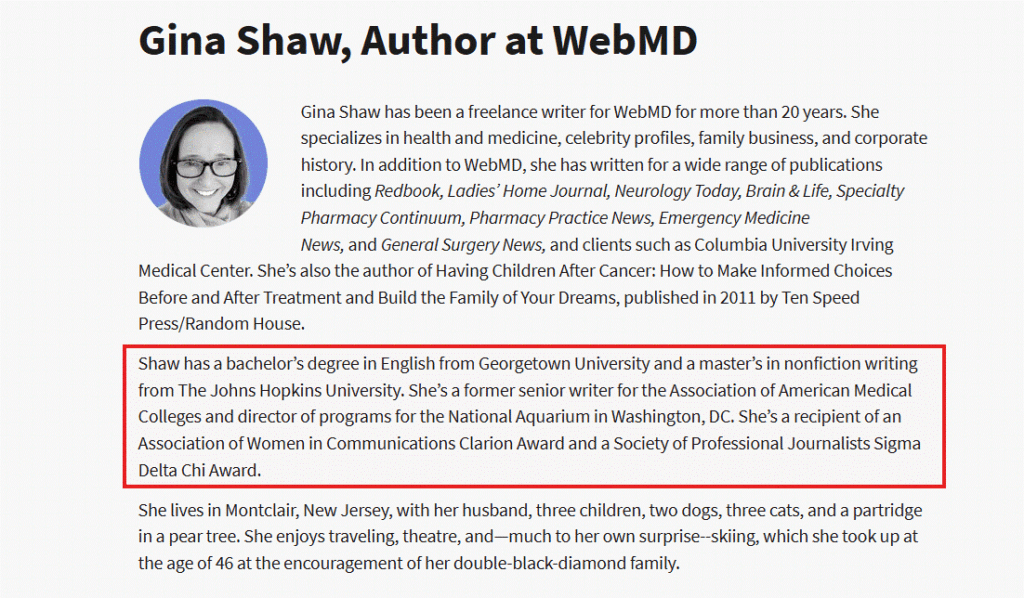
Instantly, any reader who stumbles on an article from her will pay attention because they know she has a lot of experience and can provide helpful suggestions to the issues they have.
- It helps your blog align with Google’s E-E-A-T guideline
When you show the author’s background and credentials, you’re telling Google that the article is from someone with enough expertise on the topic.
It also helps you expand the author’s digital footprint on the internet to increase their credibility.
- Signals to LLMs and AI search platforms
ChatGPT, Gemini, and Perplexity AI use author credibility to decide the post they recommend in their responses. The more you appear as a credible author who has written relevant, quality content, the more these AI tools will recognize your expertise and link to your content as a credible expert.
For instance, I asked Perplexity AI who Adam Heitzman is, and it gave a detailed answer:

If there were no author boxes on our website (and the websites our Managing Partner guest writes for), the response may not have been this specific and helpful.
How to Create Author Boxes That Improve Trust Signals
Here’s a simple way to create an author box:
1. Add all elements to satisfy Google’s E-E-A-T standards
Google evaluates content quality through four specific criteria: Experience, Expertise, Authoritativeness, and Trustworthiness (E-E-A-T). This criteria is Google’s way of knowing if your page creates helpful, people-first content.
You can also use this approach with your author box. Here are the things to do:
1. Always add your area of Experience
Experience means first-hand, real-world involvement with your topic.
Google looks for evidence of experience with the topic you’re writing about, and assesses your page based on its findings.
To pass Google’s experience criteria with your author box, you must:
- Show measurable and time specific experiences
Rather than say “John Doe has years of experience in the SEO industry, write “John Doe has 15 years of experience managing SEO campaigns for Fortune 500 companies.”
Regardless of the way you tweak yours, always use specific numbers. This helps readers know how long you’ve been in the industry, and they can use that knowledge to decide whether to trust you or check another blog.
- Include specific tools and processes you’re good at.
If you want to write something you’re great at, be specific.
Rather than write a generic phrase like “skilled in digital marketing,” write a line that shows your experience is better. For example, “X is proficient in technical SEO and has helped x amount of companies audit broken links, troubleshoot page load speed, and help clients resolve design flaws that affect conversion rate.
The more specific, the better.
2. Expertise
Expertise is about your formal and informal knowledge in a specific field. This includes your education, training, certifications, and specialized knowledge.
While writing about your expertise, start with your relevant credentials.
Put your most impressive, topic-relevant qualifications first. If you write about diabetes, for instance, add your endocrinology fellowship to show that you have expertise in the topic.
You can also add your ongoing education or training, if necessary. For example, where possible, write the certifications you have and the conferences you’ve attended.
This shows that you are always learning, and it’s always important for content where you need readers to trust you.
LaToya Irby does it well here:

3. Authoritativeness
Authoritativeness means others in your field recognize your expertise.
Google looks for external validation of your knowledge and reputation. For your author box, one of the ways to show authoritativeness is by highlighting your previously published work.
Mention articles in trade publications, research papers, and other popular studies you’ve contributed to.
You can also include links to your speaking engagements. These can be conference presentations, webinar appearances, or podcast interviews that show that others value your insights enough to feature you.
Here’s an example:

4. Trustworthiness
Trustworthiness combines accuracy, transparency, and ethical standards. This is especially important for YMYL content, where bad advice can cause real harm.
A rule of thumb here is to be transparent about potential conflicts of interest. If you work for a company you’re writing about, mention it. If you receive affiliate commissions from a promotional piece of content, you must also disclose it.
This transparency helps people trust you more. It can even encourage the readers to take a specific action you want them to take.
In addition to that, add links to your LinkedIn profile and company website so readers can check your social media accounts when necessary.
Here’s an example from Patrick Stox, technical SEO expert at Ahrefs.

Other elements you should add to your profile includes:
- Author’s name and professional headshot.
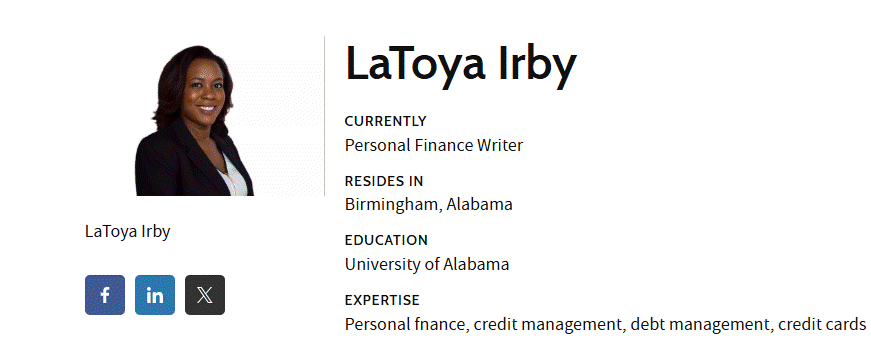
Your name and picture familiarize the reader with you. In the medical industry, for instance, research shows that 77% of people look for photos before they make appointments with healthcare providers.
Another study from Doximity’s ecosystem shows that doctors with profile photos on their pages get viewed twice as often as doctors without them.
All these show that a good headshot always increases trust in people.
- Add current role and affiliation with your company
Readers want to know where you work now and what you do there.
Here’s how Patrick Stox described it:
“Patrick Stox is Product Advisor, Technical SEO, and Brand Ambassador at Ahrefs. Before that he was a Technical SEO at IBM for many years, worked at an agency, had his own consultancy, and was in-house at a B2B company. A long time ago he started his career as a developer.”
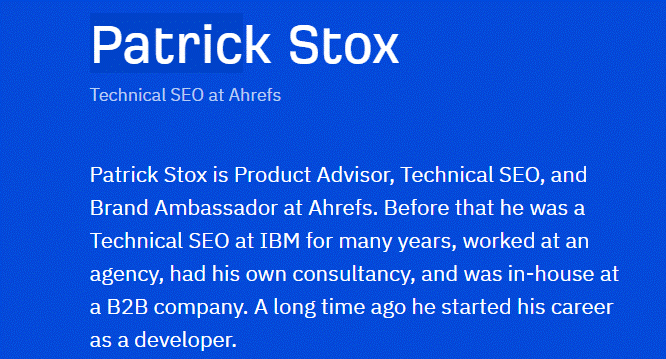
Here, you can see what his current role is, the companies he has worked in the past, and how his role (and experience) connects to the blog post he has written.
This helps you trust the author more, and your readers will feel the same way.
2. Design & placement best practices
Your author box design directly influences how readers will engage with your content. A rule of thumb is to place the author box at the beginning (or the foot) of the article as your primary location:
Here’s an example:
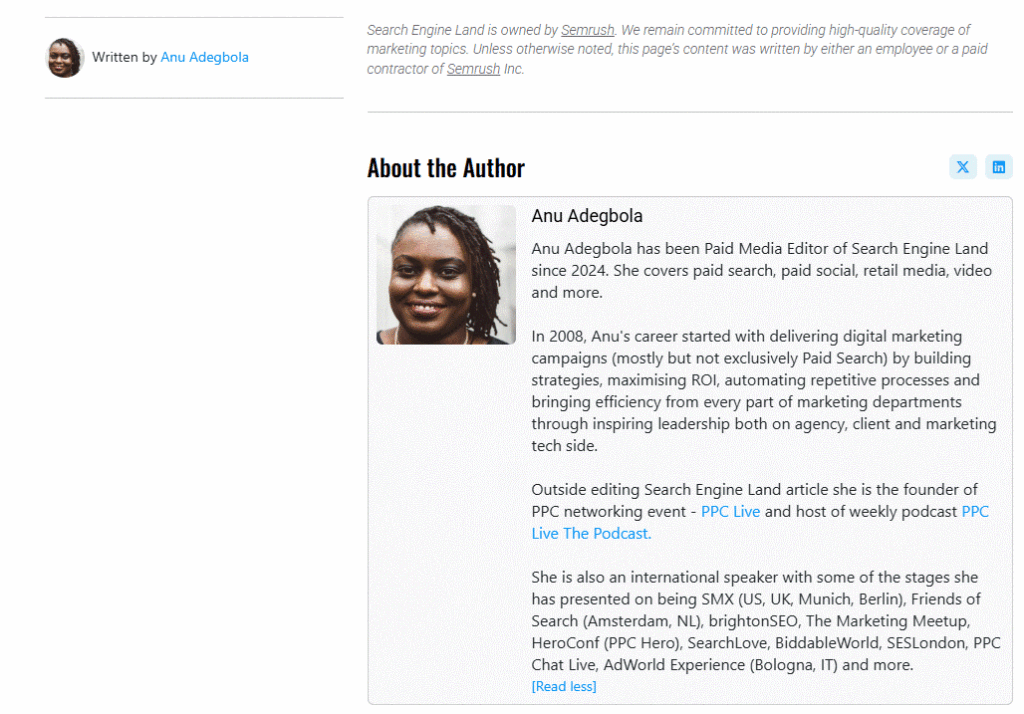
This way, your reader can see who the author is (before they read the article) and learn more about the author (after they complete the article).
If you don’t want to write the full author bio at the top of the page, write a concise version like WebMD does here:

This way, readers can click on their link to read more about who they are and what their qualifications are.
💡Tip: Don’t write author boxes on your sidebar
About 96.3% of internet users browse on their mobile phone, so it’s important to design your author boxes for mobile use.
Sidebars can hide or push content around on smaller screens, so make sure they display properly below your content on mobile devices. You can confirm this with a mobile phone.
Other design tips you should consider include:
- Use user-friendly fonts so readers don’t have to zoom in and out to read. Your author name should be easily readable at 16px minimum.
- Space your links (especially to their social media profiles), so they can know where each link leads. You can also design it like this:
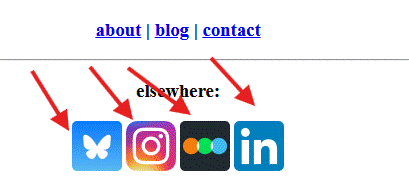
This way, every social media account is separate.
- Compress author photos to avoid slow page speed. You can use tools like TinyPNG to reduce file size without losing quality.
- Use your website’s color scheme, typography, and spacing patterns. Your author box should feel like a part of your website.
- Add structured data that tells search engines who wrote the content, their credentials, and their affiliations. This can help your content appear in rich snippets and build author authority signals. More about this below:
3. Use person schema for your authors
Person schema markup helps search engines identify who the author of a page is.
When you properly mark up author information, Google can display enhanced search listings that include author details, which could increase your click-through rates.
To add an author schema to your pages, you need these core properties:
- @type: “Person” – Specifies that the author is an individual person (not an organization).
- name – The author’s full name as it appears publicly.
- url – Link to the author’s bio page or professional profile.
- image – High-quality professional headshot (compressed for fast loading).
- sameAs – Array of social media profiles and other authoritative pages about the author.
- jobTitle – Current professional title or role.
- worksFor – Organization the author is affiliated with.
- knowsAbout – Topics or areas where the author has expertise.
Once you’ve gathered this information;
- Create the JSON-LD schema code
Author schema uses JSON-LD format, which goes in a <script> tag. The structure looks like this:
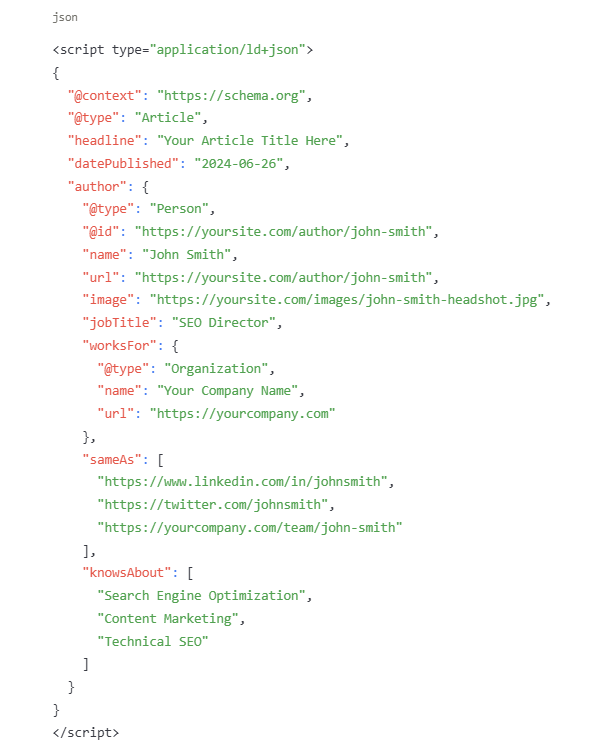
- Implement the code into your page.
If you use a WordPress site;
- Add the JSON-LD code to your theme’s header.php file within the <head> section.
- Use plugins like Schema Pro or RankMath that include author schema functionality.
- Add custom code to your functions.php file that generates the schema automatically.
For other content management systems (CMS):
- Insert the JSON-LD script directly in your page’s <head> section.
- Add it just before the closing </body> tag if head access is limited.
- Use your CMS’s custom code functionality to include the schema site-wide.
- Create dedicated author bio pages
Google recommends linking to comprehensive author bio pages to help disambiguate authors. See below:
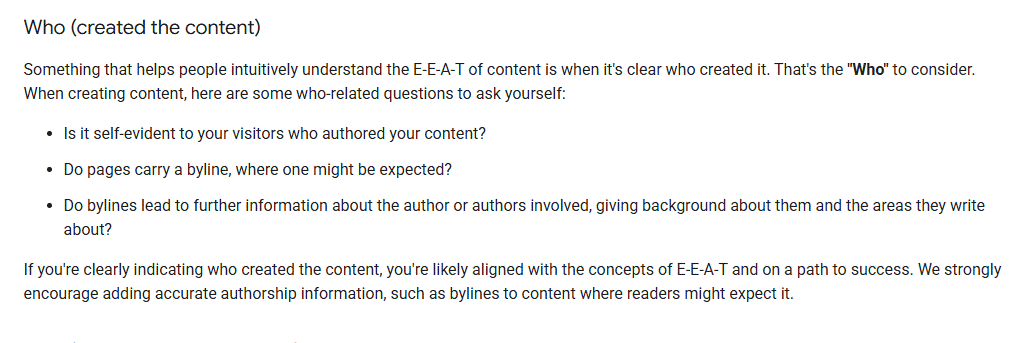
Indicate who created the content clearly to align your content with Google’s E-E-A-T, so make sure each author bio page you create includes the details we’ve mentioned earlier (name, professional background, experience, etc.)
- Validate and test your schema
Before you publish your script, use Google’s Rich Results Test to validate your code.
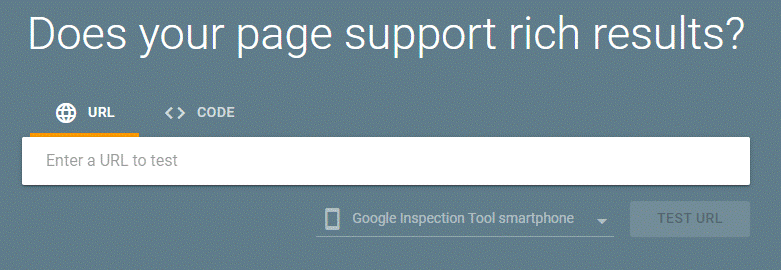
Paste your URL or code snippet to check for errors you could have made while creating the code.
You can also test with Schema Markup Validator to further validate after you’ve used the Google Rich Results Test.
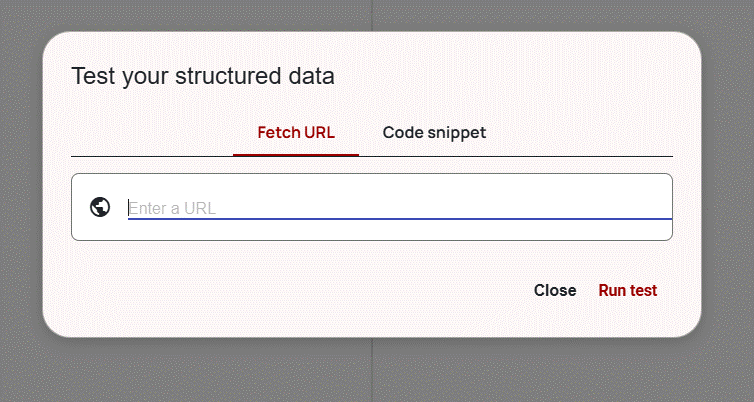
After you add the schema to your page, check for any structured dates errors or warnings on your Google Search Console to reconfirm it. If you’re in the clear, monitor your page to see if it comes up in rich snippets (this isn’t a guarantee).
Conclusion
Author boxes build trust with readers. It also helps you increase brand recall.
There are probably a few people you trust when it comes to personal finance or investing in the stock market. Known names may include Dave Ramsey and Warren Buffett. These people have built authority over time by doing and talking about what they do.
Your author box is an opportunity to do this. It helps you create a profile for yourself on the internet (not on social media), so that when people search for you, they’ll find your opinions on relevant topics. This can improve your credibility as an expert and a go-to author for industry problems or questions.
